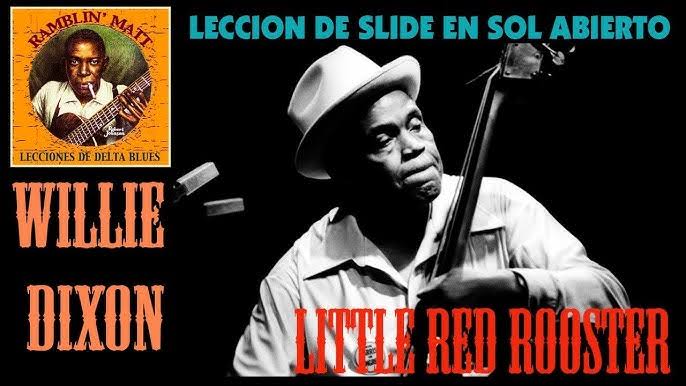
One of the most iconic and influential figures in the history of blues music, Willie Dixon, was the driving force behind many of the genre’s greatest hits. Among his most enduring contributions to the blues legacy is the song “Little Red Rooster,” a track that has since become a standard, performed by countless artists across various genres.
The Birth of “Little Red Rooster”
“Little Red Rooster” was written by Willie Dixon in 1961, during his time working as a staff songwriter and producer for Chess Records, the legendary Chicago-based label that was home to many of the greatest blues and R&B artists of the 1950s and 1960s. The song was originally recorded by blues legend Howlin’ Wolf, one of the most powerful and distinctive voices in blues. Howlin’ Wolf’s unique interpretation of Dixon’s words, combined with his raw vocal delivery and the stark, minimalist instrumentation, helped make “Little Red Rooster” an instant classic.
The song’s narrative is rooted in traditional blues themes: love, longing, and the complexities of human relationships. The titular “Little Red Rooster” symbolizes a man’s need for affection and companionship. The lyrics depict a rooster that struts around proudly, seemingly in control of his world, but there’s an underlying sense of vulnerability and insecurity.
The Lyrics and Their Significance
The lyrics of “Little Red Rooster” paint a vivid picture of a rooster that runs things around the farm, but the meaning behind the song goes beyond its surface narrative. Dixon’s words evoke feelings of pride and loss, the rooster representing a man who commands attention and respect, but ultimately still finds himself longing for something greater. The song’s repetition and stark imagery reflect the cyclical nature of desire and emotional turmoil.
Dixon’s ability to weave personal and relatable themes into his music helped establish him as one of the greatest blues songwriters. His lyrics in “Little Red Rooster” are simple, yet emotionally resonant, a hallmark of his songwriting style.
The Influence of Willie Dixon
Willie Dixon was not only a songwriter but also a bass player, arranger, and producer who had an immeasurable impact on the Chicago blues scene and the broader 
Dixon wrote some of the most influential songs in blues history, including “Hoochie Coochie Man,” “I Just Want to Make Love to You,” and “Spoonful.” His contributions transcended the boundaries of blues, as his work would go on to influence rock bands, including The Rolling Stones, Led Zeppelin, and The Doors.
His style was deeply rooted in traditional African American blues, but he also blended in elements of jazz, gospel, and R&B, creating songs that were not only timeless but also adaptable across different musical genres. Dixon’s ability to balance storytelling with musicality is part of what made his songs so enduring.
The Legacy of “Little Red Rooster”
“Little Red Rooster” gained widespread recognition beyond its initial release. Its influence on the blues and rock genres is undeniable. In 1964, British blues band The Rolling Stones famously recorded a version of the song, which helped bring the track to an even broader audience, particularly in the United Kingdom. Their cover of “Little Red Rooster” reached No. 1 on the UK Singles Chart, solidifying the song as an international blues classic. The Stones’ version stayed true to the song’s roots while adding their own flair, bringing attention to both the song and its original composer.
Dixon’s impact is still felt today. His music continues to be performed by blues musicians and has been covered by artists from a variety of genres, ensuring that “Little Red Rooster” remains a timeless blues anthem. The song’s combination of rhythmic simplicity, melodic charm, and emotional depth continues to resonate with audiences around the world.
Look at Willie Dixon’s Life and Career
Born in 1915 in Vicksburg, Mississippi, Willie Dixon grew up in a musical family and was exposed to the sounds of gospel, blues, and jazz early on. He moved to Chicago in the 1930s, where he would become a key figure in the city’s burgeoning blues scene. Dixon’s talents as a bass player were quickly recognized, and he joined various bands, including those led by artists like Muddy Waters and Howlin’ Wolf.
In the 1950s, Dixon’s career took off when he became a staff songwriter for Chess Records. His ability to write songs with universal appeal, combined with his keen understanding of the blues genre, made him a highly sought-after collaborator. Dixon’s songs were not only powerful musically but also layered with emotional depth, allowing them to connect with a wide range of audiences.
As a producer, Dixon helped shape the sound of many of the era’s most influential blues records, while his work as an arranger helped define the distinctive sound of Chicago blues. He was inducted into the Blues Hall of Fame in 1980 and posthumously into the Rock and Roll Hall of Fame in 1994.
Leave a Reply